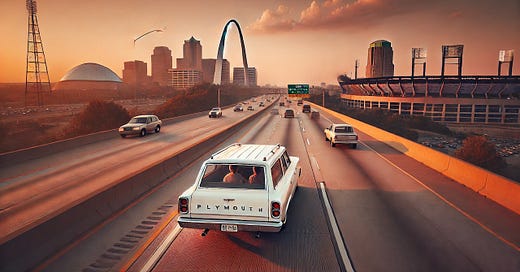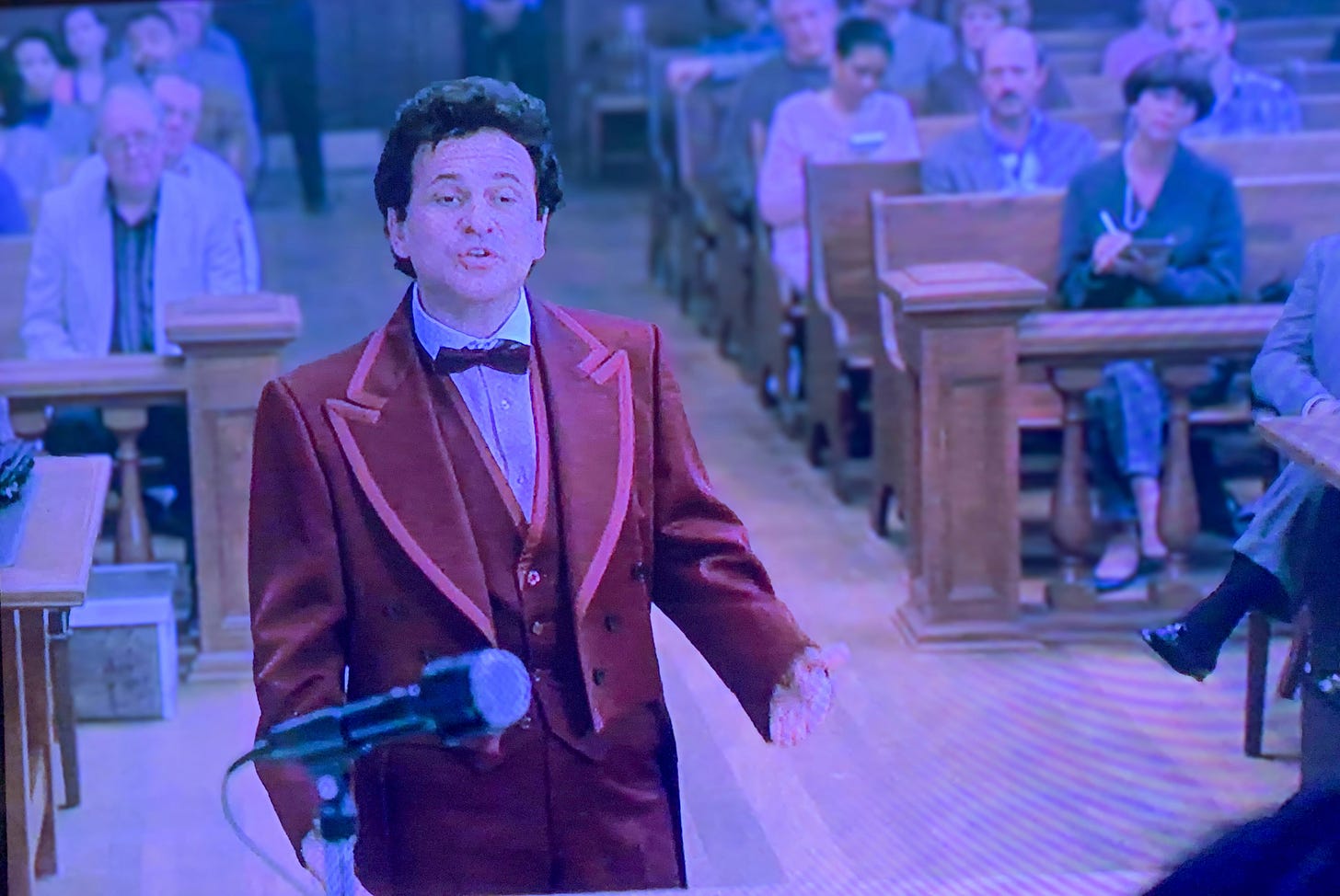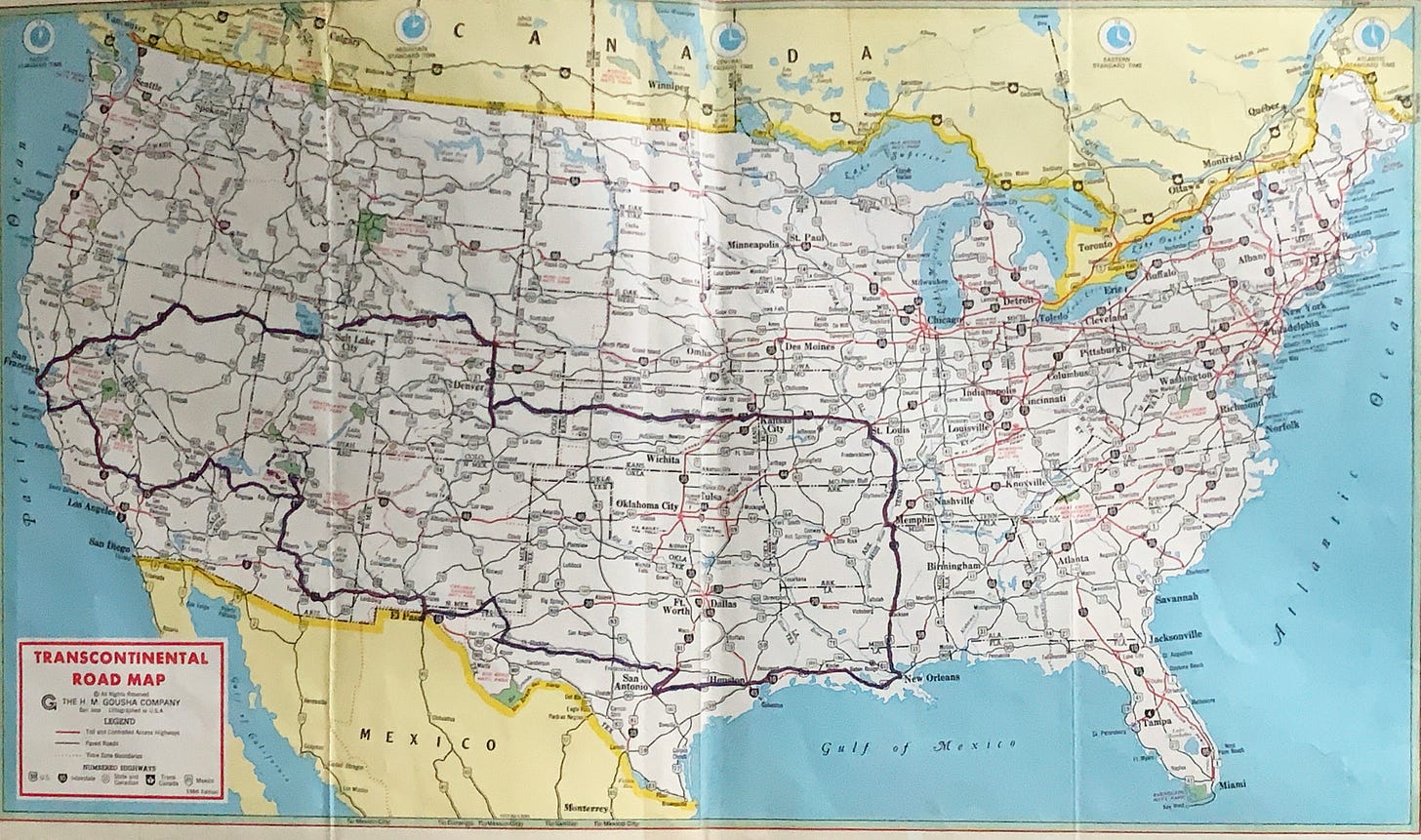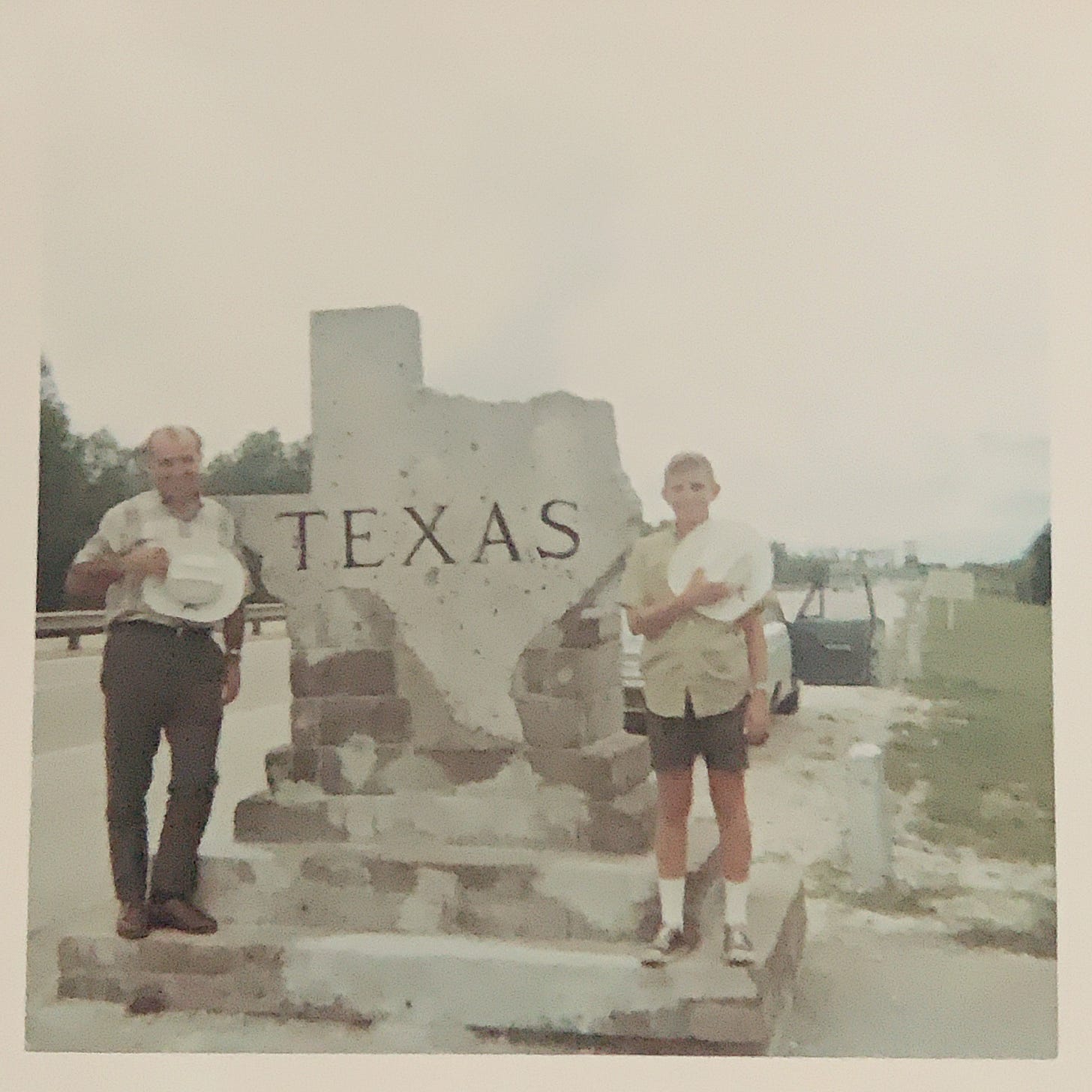A Baseball Road Trip & Journey Through Time
A ballpark adventure, a missing dress, and a lesson in regret.
Welcome to a newsletter themed at the intersection of longevity and wine history. 🍷
In August of 1967, Grandpa Mario closed the Gemello Winery for a few weeks to take Grandma Kay and my uncle Mark, 13, on a baseball-themed road trip throughout the Midwest.
A wave of new ballparks and monuments had swept the country, including The Houston Astrodome, deemed the “Eighth Wonder of the World” opened in 1965, Busch Memorial Stadium (1966) and The Gateway Arch (1967), both in St. Louis. Along the way, they also planned to catch a Kansas City A’s game at Municipal Stadium, the final year it would play host to the A’s before the team moved west to Oakland, California.
The Gemello’s first stop, though, after leaving their home in Mountain View, California, was not a baseball city but a small Nevada town called Sparks on the eastern edge of Reno. Grandma Kay was excited to see singer Patti Page perform in the Celebrity Showroom of the Golden Nugget Casino. Sparks was a small town, just under 24,000 residents.1 While the Nugget has played host to big name acts, like Tony Bennett and Liberace, on most nights, the casino’s primary attraction was Bertha the Elephant in the Circus Room.
Sparks’ small-town vibe was a problem that Sunday afternoon as Mark and Grandpa Mario unloaded the car.
“Mark came into the hotel room from unloading the car, jumped on the bed and said, ‘That’s everything!’” Grandma Kay told me recently.
She looked around and didn’t see her dresses. “What do you mean? Where’s my garment bag? Don’t tell me we left them laying on the washer and dryer at home!”
Even Reno, the metro hub, wasn’t that big of a town then, home to just under 72,000 residents. Therefore, it wasn’t easy for out-of-towners to find a store open on Sundays to sell Grandma Kay a dress for a concert that night.
“It was like a scene out of [the movie] My Cousin Vinny, where there was only one store in a tiny Arkansas town that sold suits. And it was closed because the whole store’s got the flu!”
Vinny Gambini (played by Joe Pesce) sporting a flamboyant tuxedo in court in the movie, “My Cousin Vinny,” after his original suit was ruined after Vinny tripped in mud.
Somehow, the Gemellos found that one small store open on Sunday, and Grandma Kay was able to buy a dress for dining out on the trip.
That one dress made a lot of appearances at dining establishments as they stopped at eight state capitals, including Salt Lake City, Utah; Cheyenne, Wyoming; Denver, Colorado, among others.
The route the family took touring part of Baseball America in 1967.
The Heart of St. Louis
In St. Louis, the trio made it in time for the San Francisco Giants four-game series against the league-leading Cardinals and their big-game pitcher Bob Gibson.
The Giants’ former slugging first baseman, Orlando Cepeda, had been traded to the Cardinals the previous year after a knee injury robbed him of most of the 1966 season. By the time Grandpa Mario and family had gotten to St. Louis, the baseball-watching world had learned what a mistake the Giants had made. Cepeda was having a great season, on his way to winning the Most Valuable Player award, with a .325 batting average and a league-leading 111 RBIs.
Uncle Mark said they arrived at Busch Stadium without tickets, hoping they could buy three at the box office or from a scalper. As luck would have it, they did, but the seats weren’t great.
“We wound up sitting way up in the top section. If there were 30 rows, we were in row 28,” Mark said.
“We wound up sitting way up in the top section. If there were 30 rows, we were in row 28,” Mark said.
Climbing the steep grade of steps in that section of Busch Stadium was no easy task, Mark recalled.
“As we climbed the steps to our seats, Grandpa was behind us, carrying all our food,” he said. “Grandma Kay was getting woozy from the climb and had to stop. Grandpa was like, Oh my God! It’s just a few more rows!”
That experience almost played out again on the same trip when they went to visit the Gateway Arch of St Louis. The tram, which opened earlier that summer, ascends 630 feet to the observation area, providing panoramic views of the Mississippi River to the east and the St. Louis cityscape to the west.
“Grandpa was the only one who went up to the top. Grandma Kay and I both can’t stand heights,” Mark said.
Cherishing Time Together
As my uncle Mark recently shared these stories with me, I couldn’t help think about a missed opportunity for my own baseball getaway with Grandpa Mario. In 1989, we were excited to see all the publicity of the SkyDome open in Toronto, Canada. I was a senior finishing high school when it opened in May.
A prominent part of the Toronto skyline near Lake Ontario, the SkyDome (now called the Rogers Centre)2 was the new home of the Blue Jays. It was the world's first stadium with a fully retractable roof. It was a big deal. The Blue Jays, a franchise that had never surpassed 3 million spectators for home games per season previously, would go on to set Major League Baseball attendance records the following couple of seasons. The team drew 3.8 million fans in 1990, then 4 million the next. Building on that atmospheric momentum, the Blue Jays, led by power hitter and five-time All Star Joe Carter, would win back-to-back World Series in 1992 and ’93.3
1967: Grandpa Mario and Uncle Mark on their way to the Houston Astrodome.
The SkyDome set a new standard for stadiums, sparking the next wave of modern Major League ballparks.
In 1990, I moved 400 miles south to attend college at Long Beach State. So the talk of a possible trip would become less frequent. I’d come home for holidays, but summers were often spent doing TV broadcast internships, often in Palm Desert, California.
Meanwhile, other state-of-the-art stadiums were opening, such as Oriole Park at Camden Yards in 1992, and Coors Field in Denver in 1995. Then in 2000, the San Francisco Giants opened its season in their own state-of-the-art stadium, Pac Bell Park (now called Oracle Park). Suddenly, the idea of going to Toronto for a first-class baseball experience had lost its luster.
Grandpa Mario passed away in 2005. We had never made the trip, probably because we had a disconnect of what the trip would have meant.
Something my mom told me when I was about seven often sticks with me regarding these disconnected moments. It was late one night in 1979. Grandpa Mario had just dropped me off at home after we had spent the evening at my church. He was my sponsor for my upcoming Catholic confirmation. As we drove by Village Host, Grandpa Mario asked if I wanted to grab a pizza.
“Gramps, it’s nine o’clock. No, thanks. I’m not hungry.”
When I got home and relayed the story to my mom, she said, “You should have gone. He loves to eat with his grandkids when grandma’s not around. No restrictions.”
“You should have gone. He loves to eat with his grandkids when grandma’s not around. No restrictions,” my mom said.
When I reflect on that moment, I’d realize Grandpa Mario’s ambition wasn’t so much about seeing the SkyDome or the newest park, but rather having that time together - an opportunity to eat ballpark food on a weekend hall pass.
Lost Chances, Lasting Lessons
I pondered the regret of missing that opportunity of making the SkyDome trip, after stumbling upon Daniel Pink’s recent book, The Power of Regret: How Looking Backward Moves Us Forward. In it, he suggests people often suffer from one of four types of regrets: foundational, boldness, moral and connection regrets.
Before reading the chapter on connection regrets, I thought that might be the one. However,
Pink describes connection regrets as when relationships fade or break due to neglect, misunderstandings or unresolved conflicts. People often regret not reaching out or making amends before it’s too late.
Over the years, I was lucky to spend a lot of time with Grandpa Mario, including one-on-one time during the last three years as he’d share his life stories with me during his cancer treatment.
Revisiting the Village-Host-pizza lesson, I try to be more aware of potential disconnects. In other words, ask for clarity when I may be misunderstanding a person’s true intention.
I frequently ran through this exercise when I was caregiving for my dad during the final three years of his life. He died of a lung disease in 2023. He was often a closed book. I sat beside him, peppering him with questions to better understand many of his intentions that puzzled me over the years. It helped me get closer to him.
How many times have you hoped to have a one-on-one conversation with a friend, only to scrap it because a third person was unexpectedly invited to dinner? Or that third person is the watchdog of your friend’s health regimen, preventing an occasional splurge?
If you’re new here—hi, I’m Kevin!
I’m the author of 🍷 Rain on the Monte Bello Ridge,🍷 my forthcoming memoir about health, aging and winemaking. (Read the origin story of the book.) 🍇
The Centenarian Playbook is my newsletter, which features:
Healthy aging/longevity tips and stories from Grandma Kay’s long life.
Wine history & stories of the Gemello Winery
Ancestry & family research tips
There are three buttons at the bottom of every post: “like,” “comment,” and “restack.” Restacking is sharing in digital form. It goes out to the Substack community. If you enjoy the content and click “Restack,” it helps a lot.
Sparks had a growth spurt starting in the 1990s. Its population has more than quadrupled to 111,000, since 1967; Reno’s population has also quadrupled as well since the late 1960s.
In 2005, the SkyDome was renamed the Rogers Center after it was purchased the previous year by the telecom giant, Rogers Communications.
The Blue Jays offense was loaded in 1992 and ’93. If it weren’t for Cleveland Indians’ Carlos Baerga tying John Olerud for second in hits with 200 in 1993, Blue Jays would have swept the top three rankings. Hall of Famers Paul Molitor and Roberto Alamar finished first and fourth in hits, respectively, that year.








Great story, Kevin!